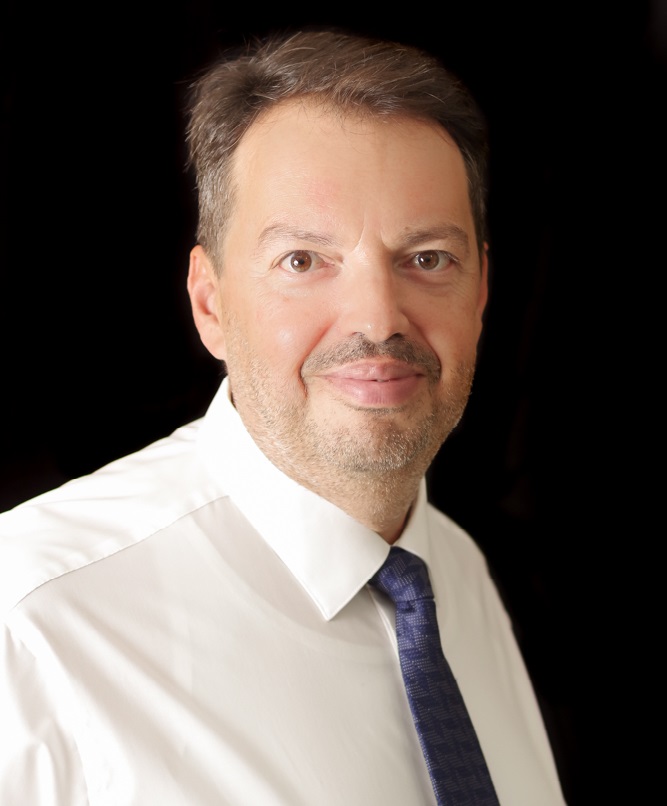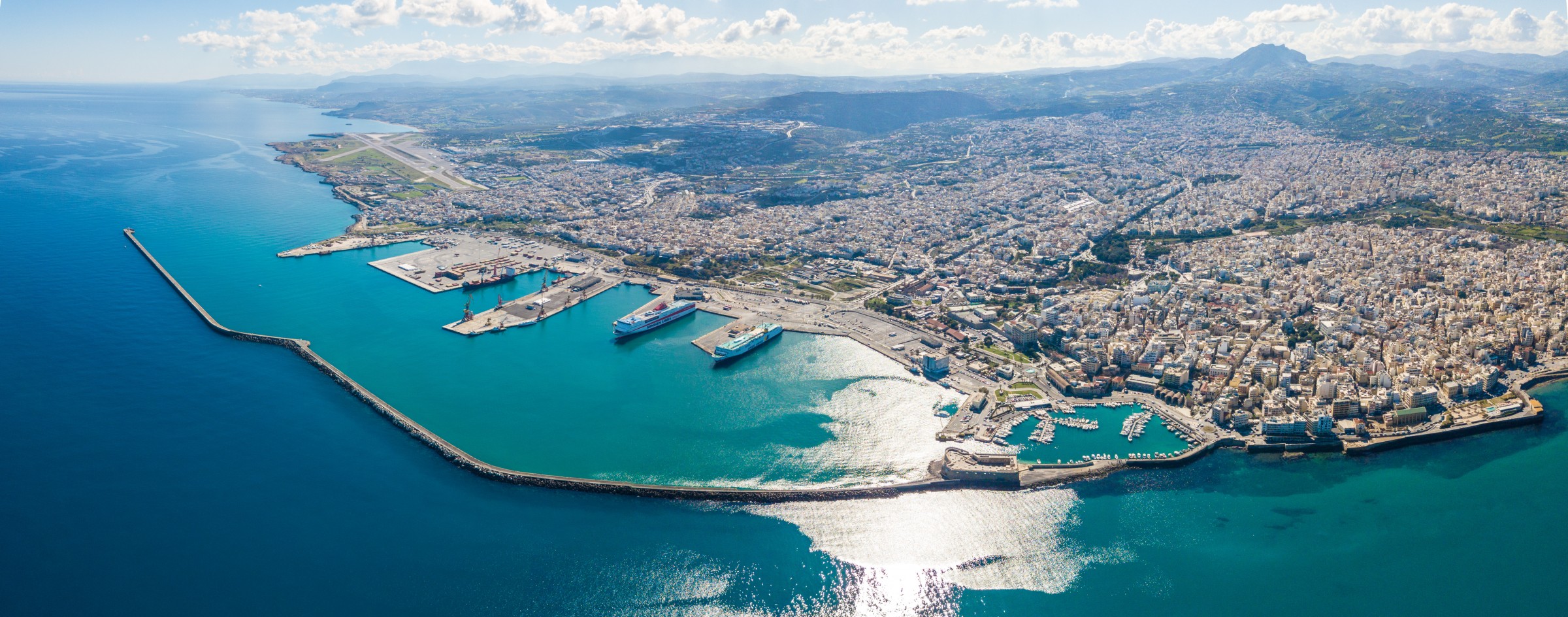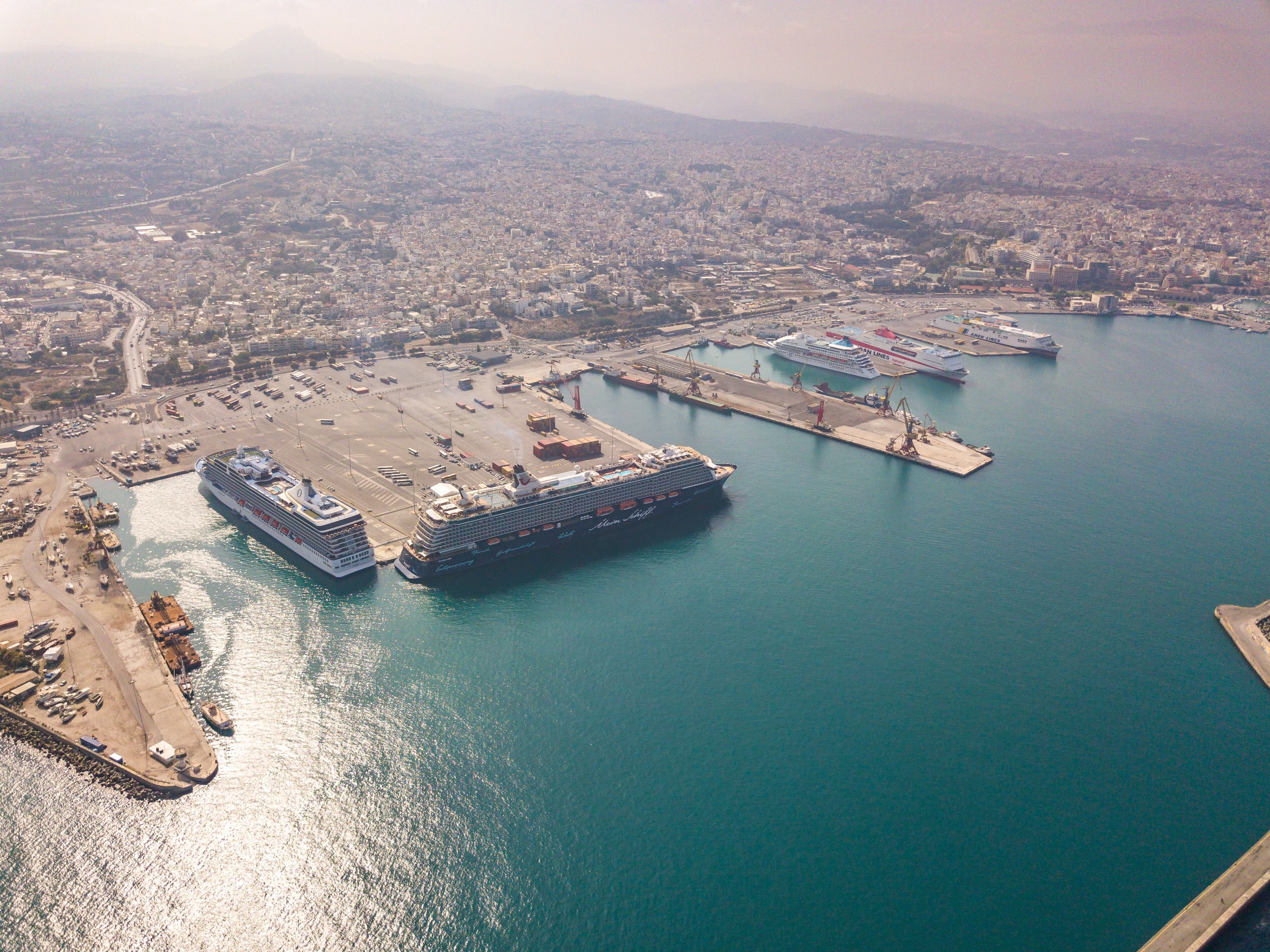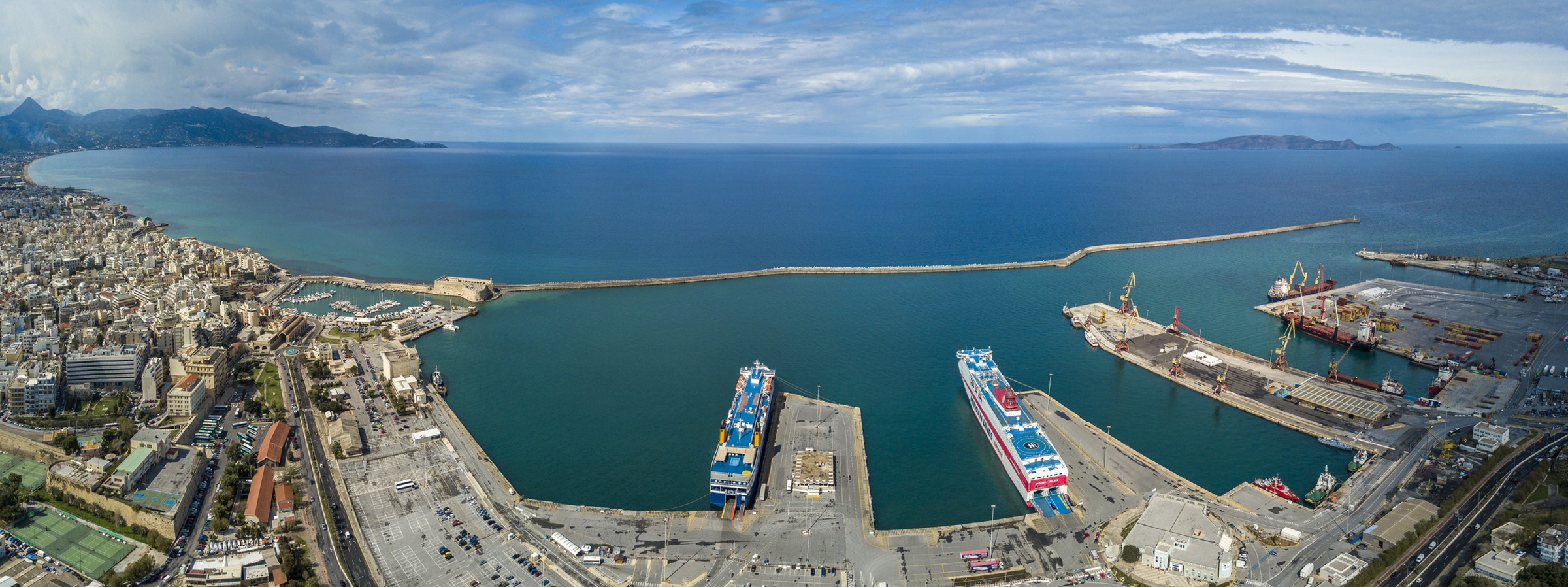31 March 2023
This month, we take you to the south, to the beautiful island of Crete. We meet with Mr. Minas Papadakis, CEO, Heraklion Port Authority. He tells ESPO about the main investment projects in the main port of Crete, the renewable energy projects and many other interesting topics to discover in this new port pro interview!
Can you briefly tell us about the Port of Heraklion? What are its main activities, characteristics and challenges?
Heraklion port is a medium-sized port of international interest belonging to the TEN-T network and the third largest port in Greece. It is located in the middle of the island of Crete and consists of the main entry gate for goods and passengers for the island. It is a multifunctional port, with all major port activities being present, i.e. ferry sector, cruise sector, cargo sector, yachting and a small shipyard. The ferry sector is very strong and is generating 42% of our revenues.
Two large Ro-Pax vessels are connecting Heraklion to Piraeus every day and 4-5 high speed ferries are connecting Heraklion to the major Cycladic islands during the summer months.
We service 1.5 million ferry passengers and 300.000 cruise passengers per annum. We rank at the 6th place among Greek ports in the cruise business with 230 cruise calls last year.
The cargo sector mainly satisfies the import and export needs of the local economy.
Our port is under a privatisation process and the main challenge we are facing is to smoothly and successfully complete the project of privatisation.

What is your long-term vision for Heraklion Port Authority? What are the main investment projects for the coming years? Could you briefly describe the importance of these investment projects for the port and the city?
Climate change is the biggest challenge that humanity is facing and will be facing in the next decades. The maritime sector is a major polluter and ports must contribute by all means to addressing the climate crisis. The green transition of Heraklion Port as well as all sustainability issues are at the fore front of our interest.
Our vision is to transform Heraklion Port to a green and smart port. Our mission is no emissions. We are working hard on the process of decarbonisation and our target is to become the first Greek port that will apply OPS system to all ships berthing at our port well before 1 January 2030 when we will be obliged to. In this direction we are completing this month the project called “Electriport” with full design studies and planning for the application of a cold ironing system to our port. Next step is to apply for financing so as to proceed with the construction phase.
We are also working on another project called “Hupiness”, to use wave energy to produce electricity by installing wave generators on the armouring of windward breakwaters. This system will produce a power of approximately 1 Megawatt (MW) and the energy produced will be used for the needs of the OPS system, so as to integrate our green transition activities.
The importance of both projects is very high for the port and the city as they will contribute not only to reducing CO2 emissions but also to reducing the total air and noise pollution thus offering better living conditions to all citizens around.
The European Commission proposed a review of the current TEN-T policy, putting more emphasis on the maritime pillar. What are your main priorities for your port in that respect? Has the port benefitted from being part of the TEN-T core network? Is the TEN-T policy fit for purpose for an island port?
Indeed, the proposed revised TEN-T policy puts the emphasis on the maritime pillar, which is crucial for the port of Heraklion. Being an island port, we are lacking rail infrastructure and of course significant hinterland. Thus, through the revised policy we expect an increase in the importance of Short Sea Shipping (SSS), the dominant market for the port of Heraklion. Thus, we will move towards exploiting new SSS connections which could increase the port’s throughput. Moreover, the revised policy aims at linking EU countries to Mediterranean neighbouring countries. Therefore, we will also focus on taking advantage of new opportunities in this respect. Finally, the emphasis on the maritime pillar provides investment opportunities for the port of Heraklion aiming at reducing greenhouse gas (GHG) emissions from shipping and port operations. Greening port operations is among the top priorities for the port of Heraklion.
Since the implementation of the TEN-T policy framework, the port of Heraklion has benefited in various ways. The inclusion of the Heraklion port in the core TEN-T network increased the geopolitical importance of the port while it allowed the port authority to gain access to EU financing and EU funded research programs.
As regards the last part of your question, TEN-T is a multifaceted tool. It is not only about cargo and passenger traffic. Greening of port operations, port digitalization, port resilience, sustainable energy production are among the goals of the TEN-T framework. As such the TEN-T is also important for insular ports.

The cruise business is a core activity of the Heraklion Port Authority. How important is the cruise business for Crete? Many different stakeholders are involved in the cruise business. How is the cooperation with all the partners, more specifically cruise lines, tourism services, and the city?
Heraklion port is among the largest cruise ports in Greece, operating as a port of call as well as a homeport. Homeporting is growing rapidly these last five years and attracts our strategic focus as revenues from homeporting are almost double than from a simple call.
Heraklion Port is very friendly to the whole cruise industry. It was the first port in the South East Mediterranean that took the initiative to restart cruising in September 2020, in the middle of the COVID-19 crisis.
The total revenues though from the cruise business constitute only 12% of the port’s total income. The cruise business is much more essential for the city and for the local economy and local entrepreneurs. This is the reason why we are putting so much effort into it.
We are in very close cooperation with the municipality of Heraklion, to promote not only the port but the destination “Heraklion”. Last year, together with the municipality, we invited GSTC to conduct a sustainability assessment for the port and the city of Heraklion, and the results were very satisfactory. I must point out that there is ample space to grow our cruise business without creating any serious sustainability problems to the city or the island of Crete.
A few weeks ago, you visited Brussels and presented the ELECTRIPORT project that relates to the provision of onshore power supply (OPS). Could you explain the project? What is the aim?
We are participating as the lead partner in the European project Electriport, together with Wartsila, the Greek Mediterranean University and companies BMG Marine, Premium Consulting, Anelixis Business Partners and MSI Hellas, aiming to become the first Greek port that will apply fully integrated electrification services for any type of ship approaching alongside. Electriport is subsidized by the Connecting Europe Facility program and is very close to its completion.
Electriport provides all the detailed studies that are needed for onshore power supply (OPS) to become timely and effectively eligible for funding. Apart from the technical options, studies cover the economic and financial aspects, delivering the financial dimensions in a complete input – output cost-benefit analysis approach. The expected outcomes contribute to the development of know-how, implementation of environmental policies, reduction of CO2 emissions in the port and consequently in the neighbouring Port–City of Heraklion.
We are planning to cover five locations for electrification; three for the ferry ships or small cruise ships and two for large cruise vessels or cargo vessels. The maximum power that we can provide is 16 MW, and this is a restriction from the local grid. With this solution we will cover the basic needs of our port, i.e. a big cruise vessel, two ferry ships and one cargo or smaller cruise vessel, berthing simultaneously.
The total energy needs of the system to cover the needs of ferries and cruise ships berthing at our port are estimated at 22.5 Gigawatt hour (GWh) per annum. The total amount for the investment is almost €15 million and the cost for the ship transmission starts from €500.000 for the ferry ships and reaches almost €1 million for the cruise ships.
This greening process of the energy mix of Crete will bring impressive results to the efficiency of the cold ironing system to our port, leading to a reduction of almost 90% of the CO2 emissions by 2028.

The EU, with its Green Deal ambitions and the REPowerEU plan, is striving to get independent from Russian fossil fuels as well as climate neutral by 2050. How do you anticipate the changing energy landscape in Europe? Do you see a role for the port of Heraklion in that respect? What will be the main challenge?
The climate crisis together with the energy crisis constitute a great challenge for the European Union. The climate crisis is not waiting. Every year we are facing more and more severe physical phenomena with dramatic effects for the whole planet. The Ukrainian war is putting much pressure for actions to overcome the energy crisis. The EU must act very fast to avoid further severe impacts for its citizens. But every threat should be treated as an opportunity. This is the great opportunity for Europe to be transformed very fast into a green energy producer.
The landscape in the maritime industry is not very clear, since there is a bundle of alternative fuels competing for the future, i.e. LNG, biofuels, ammonia, hydrogen etc. The port of the future will be an energy hub, covering as much as possible solutions from the alternative fuels bundle.
This the role we believe Heraklion Port can play in the future and its strategic position in the middle of the South East Mediterranean actually enhances its importance as an energy hub.
European ports are increasingly investing in digital solutions to improve the efficiency of the logistics chain and port operations. Has the Heraklion Port Authority taken any initiatives towards digitalisation?
Our major initiative in the area of digitalisation is a proposal for a development of a Digital Twins model for our port. This model, through the application of new technologies, will offer us the opportunity to have an image of the port and its basic infrastructure (i.e. piers, breakwater etc) as well as data and information relevant to the port, its facilities and its operations.
The purpose of this “Digital Twins” model is to develop a useful tool for the management of the port’s resources and infrastructure so as to provide a clear image of their condition at any moment and to be able to identify any potential source of problems.
The greening of a port is a task which requires the help of all port stakeholders. What can a port authority do to engage all stakeholders in making their operations more sustainable? You are part of the EcoPorts Network, how important is this for you?
Sustainability is not a lonely exercise. In order to achieve the required results all stakeholders must be involved and actively participate in every step of the process.
The port authority has many different tools to actively engage stakeholders. First of all, we have to educate people and communicate that sustainability is our top priority. Then we can give incentives, especially to our customers, either financial incentives or non-financial rewards.
We can also develop sustainability criteria to opt for those that fulfil these criteria and are fully committed to the decarbonisation process.
It is very important for the Heraklion Port to be part of the EcoPorts Network, since it provides a field for cooperation and sharing of knowledge between ports.
How did you get into maritime transport? How did your career path lead to this position?
I have been working for the financial sector for the last 27 years. My first exposure to the maritime sector was some twenty years ago, when I was elected as a member in the board of directors of Minoan Lines, one of the largest ferry companies in Greece. I held this position for six consecutive years. I found the maritime industry very interesting and very challenging.
When I was offered the position of the CEO of Heraklion Port, with my main goal being to help the project of the privatization of the port, I did not have any second thoughts. I decided to switch to the maritime sector, a sector that I admire and love.

Related documents
No attachments.
